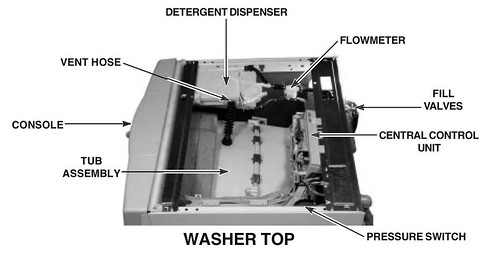A common complaint about front loading washers is mildew odor, or Das Schmeel. We professional appliantolgists refer to this condition as Funk from Within Syndrome (FFWS). So, here are some causative factors and other Fun Facts to Know and Tell (FFTKAT) about FFWS:
1. Using conventional detergent instead High Efficiency (HE) detergent.
Why would someone spend the extra money to buy an expensive front loading washer and then try to pinch pennies using conventional detergent? Even though you and I immediately recognize this as the penny-wise, dollar-moron type thinking so in vogue among the Great Unwashed, this is exactly what many people do. I dunno, I reckon they think they’re being clever and wise by disregarding the manufacturer’s explicit instructions about this. Open your Appliantology Hymnal to the Book of Washers and sing along with me now:
But the truth is that the ichiban killer of drum bearings in any front-loading washer is non-HE detergent. HE: High Efficiency. And no, using a smaller quantity of conventional detergent is not the same as using HE detergent, as explained below.
Y’see, HE detergent is not simply a concentrated formulation of the regular stuff. Since front loaders use much less water than top loaders (about 12 gallons per wash load vs. about 56 gallons in a conventional top-loader), front-loaders require a detergent with a whole different chemistry. So let’s answer some common questions and dispel common myths about front-loaders and HE detergents. [read more]
Ahh, nothing like a good, rousing hymn to really get me going on my soapbox (I know, I know, but I just couldn’t resist).
So, using the wrong kind of detergent in your fancy front loader is a great way to funkify your washer and impart some o’ dat funk onto your clothes. And it accelerates the mechanical deterioration of your washer. Smooth move, Ex Lax!
2. Using too much fabric softener and/or detergent.
Liquid fabric softener does not break down very well in cold water and the residue collects on the outer tub and basket along with the lint left from the wash. We professional appliantologists refer to this accumulated grunge as Gookus (that’s a professional term, please don’t use it at home as I cannot be responsible for your safety). Once formed, this gookus collects ever more additional soap, dirt, grease, human waste, mites, flea doo-doo, parasites… and then some really bad stuff.
As it turns out, this gookus makes a perfect substrate for microbial life forms. Over some time– not very much time in warmer climates– those little bacterial colonies build up lots of microbial sewage, just like we do (bacteria are kinda like people that way) until one day you open the door to the washer and exclaim, “Lord, he stinketh!”
Bonus FFTKAT: Using too much fabric softener will waterproof your clothes. Pop Quiz: How clean do you think your clothes will get if they repel water inside the washing machine?
3. Doing all your wash loads in cold water only.
Detergents don’t dissolve as well in cold water. As a result, cold water washes leave behind more gookus. So… do an occasional wash in hot water. OK, maybe more than occasional. Like, I hope you at least wash your skivvies in hot water. Oy!
4. Leaving clothes in the washer at the end of the cycle.
Front loaders don’t have as much access to open air as top load machines. Consequently, leaving clothes in the washer for more than eight hours will increase mold and mildew build up. Think warm, dark, moist and you’ll get inside the brain of a mold spore. Visualize the spore; BE the spore!
:::
Now that we have a vast and awesome under-stinking-standing of FFWS, I’ll offer some of the preferred Samurai-Approved Maneuvers for Front-Loader Olfactory Bliss (SAMFOB). These sacred techniques are three ancient Hot Bath Washer Purification Rituals (HBWPR) referred to as Ichi, Ni, and San:
1. Ichi: Add one additional gallon of hot water to the unit before sending it into a hot wash. This will raise the water level high enough to remove the Gookus Hiding Behind the Basket (GHBB).
2. Ni: Same as Ichi, but with bleach added to all dispensers. Clean the fabric softener cup with a rag first (bleach will not break up fabric softener since it is introduced in the rinse cycle with the fabric softener).
3. San: Same as Ichi and Ni but with a cap full of pine cleaner added to the wash water (NOT the dispenser). Add some old rags (they don`t need to be dirty) and select the extra rinse cycle. The wash action will help remove the accumulated gookus from the components
Once again, make sure you’re only using high efficiency (HE) detergents in your front loader. See this page for the gory details on why dis be.
And here’s a bonus tip from a loyal reader of these hallowed pages:
Jo, moderate fix-it-myselfer, maximum beer drinker, wrote:
If it please the Samurai, a great way to keep front load washers smelling sweet and also clean is to add up to one cup of vineagar every couple of loads. Economical, and a nice mild disinfectant as well. Can be added during wash cycle, or rinse if you don’t mind a mild vineagar smell.
Awwite, go whup up on some stanky! 

To learn more about your washing machine, or to order parts, click here.





